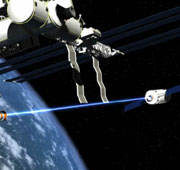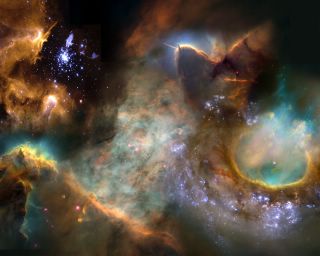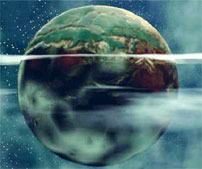
Tuesday, May 24, 2005
Friday, May 06, 2005
hello everyone, blogging again. today compo papers, i tink my chinese paper gone liao... coz i dunno wad i writting myself ! going home, kenny n i took the wrong bus! 33 instead of 31, then we stopped at lavender MRT station. heng we stopped at the MRT station, if not i cannot imagine how to find my way home 

Wednesday, May 04, 2005
Beam Me to Mars
"Are we there yet?" Everyone has faced this exasperating question from impatient companions on a long road trip. Imagine if the trip lasted six months. One way.
With conventional rockets, a roundtrip to Mars could last as long as three years, because an extended stay is required while the orbits of Earth and Mars align again for the return trip.
But an exciting NASA-funded research project could send astronauts racing to Mars up to six times faster. The solution -- proposed by Dr. Robert Winglee of the University of Washington -- sounds like science fiction. A spacecraft rides a beam of plasma, which is electrified and magnetized gas, all the way to Mars and back. The roundtrip journey could be wrapped up in about 90 days using Winglee's Magnetized Beam Plasma Propulsion system, dubbed Magbeam.
How It Works and Where It Came From
The system would use space stations to generate the plasma and beam it to a spacecraft. The spacecraft generates its own magnetic field, which deflects the plasma beam. Like wind pushing on an umbrella, the deflection of the plasma beam generates a force that propels the spacecraft. Another space station orbiting the destination generates a beam to slow down the spacecraft upon its arrival, and to launch it on the return journey.
adapted from www.nasa.gov

"Are we there yet?" Everyone has faced this exasperating question from impatient companions on a long road trip. Imagine if the trip lasted six months. One way.
With conventional rockets, a roundtrip to Mars could last as long as three years, because an extended stay is required while the orbits of Earth and Mars align again for the return trip.
But an exciting NASA-funded research project could send astronauts racing to Mars up to six times faster. The solution -- proposed by Dr. Robert Winglee of the University of Washington -- sounds like science fiction. A spacecraft rides a beam of plasma, which is electrified and magnetized gas, all the way to Mars and back. The roundtrip journey could be wrapped up in about 90 days using Winglee's Magnetized Beam Plasma Propulsion system, dubbed Magbeam.
How It Works and Where It Came From
The system would use space stations to generate the plasma and beam it to a spacecraft. The spacecraft generates its own magnetic field, which deflects the plasma beam. Like wind pushing on an umbrella, the deflection of the plasma beam generates a force that propels the spacecraft. Another space station orbiting the destination generates a beam to slow down the spacecraft upon its arrival, and to launch it on the return journey.
adapted from www.nasa.gov

Sunday, April 24, 2005
Tuesday, April 12, 2005
Thursday, April 07, 2005
Ancient Extinction
Scientists at NASA and the University of Kansas say that a mass extinction on Earth hundreds of millions of years ago could have been triggered by a star explosion called a gamma-ray burst. The scientists do not have direct evidence that such a burst activated the ancient extinction. The strength of their work is their atmospheric modeling -- essentially a "what if" scenario.
The scientists calculated that gamma-ray radiation from a relatively nearby star explosion, hitting the Earth for only ten seconds, could deplete up to half of the atmosphere's protective ozone layer. Recovery could take at least five years. With the ozone layer damaged, ultraviolet radiation from the Sun could kill much of the life on land and near the surface of oceans and lakes, and disrupt the food chain.
Gamma-ray bursts in our Milky Way galaxy are indeed rare, but the scientists estimate that at least one nearby likely hit the Earth in the past billion years. Life on Earth is thought to have appeared at least 3.5 billion years ago. This research, supported by a NASA astrobiology grant, represents a thorough analysis of the "mass extinction" hypothesis first announced by members of this science team in September 2003.
"A gamma-ray burst originating within 6,000 light years from Earth would have a devastating effect on life," said Dr. Adrian Melott of the Department of Physics and Astronomy at the University of Kansas, Lawrence. "We don't know exactly when one came, but we're rather sure it did come -- and left its mark. What's most surprising is that just a 10-second burst can cause years of devastating ozone damage," Melott added.
A scientific paper describing this finding appears in Astrophysical Journal Letters. The lead author is Brian Thomas, a Ph.D. candidate at University of Kansas.
Gamma-ray bursts are the most powerful explosions known. Most originate in distant galaxies, and a large percentage likely arise from explosions of stars over 15 times more massive than our Sun. A burst creates two oppositely-directed beams of gamma rays that race off into space.
Thomas says that a gamma-ray burst may have caused the Ordovician extinction 450 million years ago, killing 60 percent of all marine invertebrates. Life was largely confined to the sea, although there is evidence of primitive land plants during this period.
In the new work, the team used detailed computer models to calculate the effects of a nearby gamma-ray burst on the atmosphere and the consequences for life.
Thomas, with Dr. Charles Jackman of NASA's Goddard Space Flight Center in Greenbelt, Md., calculated the effect of a nearby gamma-ray burst on the Earth's atmosphere. Gamma- rays, a high-energy form of light, can break molecular nitrogen (N2) into nitrogen atoms, which react with molecular oxygen (O2) to form nitric oxide (NO). NO will destroy ozone (O3) and produce nitrogen dioxide (NO2). NO2 will then react with atomic oxygen to reform NO. More NO means more ozone destruction. Computer models show that up to half the ozone layer is destroyed within weeks. Five years on, at least 10 percent is still destroyed.
Next,researchers calculated the effect of ultraviolet radiation on life. Deep-sea creatures living several feet below water would be protected. Surface-dwelling plankton and other life near the surface, however, would not survive. Plankton is the foundation of the marine food chain.
Dr. Bruce Lieberman, a paleontologist at the University of Kansas, originated the idea that a gamma-ray burst specifically could have caused the great Ordovician extinction, 200 million years before the dinosaurs. An ice age is thought to have caused this extinction. However, gamma-ray burst could have caused a fast die-out early on and also could have triggered the significant drop in surface temperature on Earth.
"One unknown variable is the rate of local gamma-ray bursts," Thomas said. "The bursts we detect today originated far away billions of years ago, before the Earth formed. Among the billions of stars in our Galaxy, there's a good chance that a massive one relatively nearby exploded and sent gamma rays our way," he added.
Adapted from www.nasa.gov

The scientists calculated that gamma-ray radiation from a relatively nearby star explosion, hitting the Earth for only ten seconds, could deplete up to half of the atmosphere's protective ozone layer. Recovery could take at least five years. With the ozone layer damaged, ultraviolet radiation from the Sun could kill much of the life on land and near the surface of oceans and lakes, and disrupt the food chain.
Gamma-ray bursts in our Milky Way galaxy are indeed rare, but the scientists estimate that at least one nearby likely hit the Earth in the past billion years. Life on Earth is thought to have appeared at least 3.5 billion years ago. This research, supported by a NASA astrobiology grant, represents a thorough analysis of the "mass extinction" hypothesis first announced by members of this science team in September 2003.
"A gamma-ray burst originating within 6,000 light years from Earth would have a devastating effect on life," said Dr. Adrian Melott of the Department of Physics and Astronomy at the University of Kansas, Lawrence. "We don't know exactly when one came, but we're rather sure it did come -- and left its mark. What's most surprising is that just a 10-second burst can cause years of devastating ozone damage," Melott added.
A scientific paper describing this finding appears in Astrophysical Journal Letters. The lead author is Brian Thomas, a Ph.D. candidate at University of Kansas.
Gamma-ray bursts are the most powerful explosions known. Most originate in distant galaxies, and a large percentage likely arise from explosions of stars over 15 times more massive than our Sun. A burst creates two oppositely-directed beams of gamma rays that race off into space.
Thomas says that a gamma-ray burst may have caused the Ordovician extinction 450 million years ago, killing 60 percent of all marine invertebrates. Life was largely confined to the sea, although there is evidence of primitive land plants during this period.
In the new work, the team used detailed computer models to calculate the effects of a nearby gamma-ray burst on the atmosphere and the consequences for life.
Thomas, with Dr. Charles Jackman of NASA's Goddard Space Flight Center in Greenbelt, Md., calculated the effect of a nearby gamma-ray burst on the Earth's atmosphere. Gamma- rays, a high-energy form of light, can break molecular nitrogen (N2) into nitrogen atoms, which react with molecular oxygen (O2) to form nitric oxide (NO). NO will destroy ozone (O3) and produce nitrogen dioxide (NO2). NO2 will then react with atomic oxygen to reform NO. More NO means more ozone destruction. Computer models show that up to half the ozone layer is destroyed within weeks. Five years on, at least 10 percent is still destroyed.
Next,researchers calculated the effect of ultraviolet radiation on life. Deep-sea creatures living several feet below water would be protected. Surface-dwelling plankton and other life near the surface, however, would not survive. Plankton is the foundation of the marine food chain.
Dr. Bruce Lieberman, a paleontologist at the University of Kansas, originated the idea that a gamma-ray burst specifically could have caused the great Ordovician extinction, 200 million years before the dinosaurs. An ice age is thought to have caused this extinction. However, gamma-ray burst could have caused a fast die-out early on and also could have triggered the significant drop in surface temperature on Earth.
"One unknown variable is the rate of local gamma-ray bursts," Thomas said. "The bursts we detect today originated far away billions of years ago, before the Earth formed. Among the billions of stars in our Galaxy, there's a good chance that a massive one relatively nearby exploded and sent gamma rays our way," he added.
Adapted from www.nasa.gov

Friday, April 01, 2005
Thursday, March 31, 2005
Wednesday, March 30, 2005
Are we alone?
Are we alone?
For centuries, human beings have pondered this question. Medieval scholars speculated that other worlds must exist and that some would harbor other forms of life.
In our time, advances in science and technology have brought us to the threshold of finding an answer to this timeless question.
The recent discovery of numerous planets around stars other than the Sun confirms that our solar system is not unique. Indeed, these "extrasolar planets" appear to be common in our galactic neighborhood.
The extrasolar planets we have discovered thus far are giants, like Jupiter and Saturn. They are unlikely to support life as we know it. But some of these planetary systems might also contain smaller, terrestrial planets like Mars and Earth.
Over the next 15 years, NASA is embarking on a bold series of missions to find and characterize new worlds. These will be the most sensitive instruments ever built, capable of reaching beyond the bounds of our own solar system.
Using a technique known as interferometry, the Keck will study dust clouds around stars where planets may be forming. It may also provide the first direct images of giant planets outside our solar system.
The Space Interferometry Mission will measure the distances and positions of stars with unprecedented accuracy. SIM's precision will allow us to detect evidence of planets just slightly larger than Earth.
Finally, the Terrestrial Planet Finder will build upon the legacy of all that have gone before it. With an imaging power 100 times greater than the Hubble Space Telescope, Terrestrial Planet Finder will send back the first photographs of nearby planetary systems.
Such a discovery would at last provide convincing evidence that we are not alone.
We will have found another Earth.
Adapted from NASA www.nasa.gov
For centuries, human beings have pondered this question. Medieval scholars speculated that other worlds must exist and that some would harbor other forms of life.
In our time, advances in science and technology have brought us to the threshold of finding an answer to this timeless question.
The recent discovery of numerous planets around stars other than the Sun confirms that our solar system is not unique. Indeed, these "extrasolar planets" appear to be common in our galactic neighborhood.
The extrasolar planets we have discovered thus far are giants, like Jupiter and Saturn. They are unlikely to support life as we know it. But some of these planetary systems might also contain smaller, terrestrial planets like Mars and Earth.
Over the next 15 years, NASA is embarking on a bold series of missions to find and characterize new worlds. These will be the most sensitive instruments ever built, capable of reaching beyond the bounds of our own solar system.
Using a technique known as interferometry, the Keck will study dust clouds around stars where planets may be forming. It may also provide the first direct images of giant planets outside our solar system.
The Space Interferometry Mission will measure the distances and positions of stars with unprecedented accuracy. SIM's precision will allow us to detect evidence of planets just slightly larger than Earth.
Finally, the Terrestrial Planet Finder will build upon the legacy of all that have gone before it. With an imaging power 100 times greater than the Hubble Space Telescope, Terrestrial Planet Finder will send back the first photographs of nearby planetary systems.
Such a discovery would at last provide convincing evidence that we are not alone.
We will have found another Earth.
Adapted from NASA www.nasa.gov
Subscribe to:
Posts (Atom)






